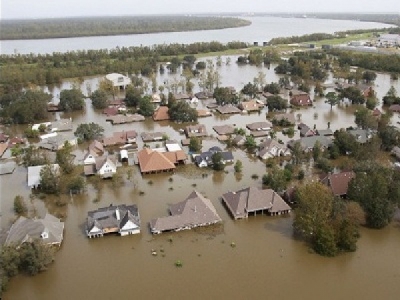
Posted on February 6, 2018
Louisiana aims to get a handle on coastal flooding and land loss, and it’s looking to the Dutch for advice.
“The Dutch have been protecting their coastline for the last 800 years,” said Justin Ehrenwerth, CEO of Baton Rouge-based research group Water Institute of the Gulf, speaking at a luncheon Wednesday in downtown Lake Charles.
Ehrenwerth said the Dutch experienced “their Katrina” in 1953 when a flood killed over 1,800 people, prompting them to “become the best in the world at dealing with water.”
After Hurricanes Katrina and Rita in 2005, he said, Louisiana began developing its own response to coastal flooding through a partnership with Dutch research group Deltares, which the Water Institute was modeled after.
Ehrenwerth said the institute — six years old today — spent its first several years helping the Coastal Protection and Restoration Authority develop a 50-year coastal master plan. He said the state’s plan has drawn the attention of countries around the world, such as Vietnam, that are dealing with similar issues.
“(Louisiana’s) not always at the top of the list,” Ehrenwerth said. “But when it comes to our coastal master plan and how we think about these issues, we are without question the best in the country. We have one of the best plans in the world, if not the best.”
Now, he said, one of the group’s priorities is updating watershed models throughout the state — some haven’t been updated in nearly 50 years — after construction has drastically altered the path of water.
Calcasieu Parish recently hired C.H. Fenstermaker and Associates to update its models, and parish Public Works Director Allen Wainwright said engineers have been studying its watershed for several years.
Because of Calcasieu Parish’s modeling efforts, and the “leadership seen in this community,” Ehrenwerth said, the Water Institute decided to stage its first real-time forecasting system in the Contraband Bayou watershed.
He said the system will use weather information and the updated watershed models to create a visual simulation of how flooding will affect the community, down to individual houses and yards.
“Imagine if five days in advance of the next storm we had this capability where we could go to the street level and predict what’s going to flood and what’s not expected to flood?” Ehrenwerth said.
He said the simulation could be broadcast to residents ahead of a major storm, so they know whether to evacuate and how to protect their homes, and could be used by engineers to develop strategies well before a storm hits.
He called it the “most cutting-edge work” of its kind and the “right way to think about these issues.” He said the goal is to expand the forecasting system to the rest of the parish and the state.
“People are paying attention to flooding, to modeling, in the way in this state that they never have before,” he said. “We’ve learned our lesson, and we want to be as prepared as possible.”
Wainwright said the parish has made “major strides” in the last five years when it comes to coastal mitigation and drainage issues.
“People are focused on it. We have awareness. Our budgets are reflecting work to be done, and I think we’re on the right track,” Wainwright said. “We’re a ways off from being done, but we’re on the right path.”
The Water Institute has also partnered with the Port of Lake Charles on a study that will identify the source of sediment building up in the Calcasieu Ship Channel, what can be done about it, and where dredged material can be placed economically.
Port leaders have said the greatest challenge facing the port over the next several years is keeping the channel dredged to its congressionally authorized dimensions of 400 feet wide and 40 feet deep.
Although the Army Corps of Engineers covers the cost of dredging, the port must buy the disposal sites and fund up to 25 percent of the cost to build and maintain levees at those sites.
Executive Director Bill Rase has said dredging activities could cost the port $80 million over the next 20 years, and that dredging sites are getting harder to find.
“The capacity we have today is equal to one Superdome,” Rase said. “With the expected 97 million cubic yards, we would need 21 Superdomes.”
Rase said companies looking to invest in the area might decide to go elsewhere if the channel isn’t dredged properly. He said the Water Institute’s study will help the port develop a plan for the future using the most up-to-date science.
He said the port expects the results of the study this spring and that leaders are “looking forward to seeing what science has to say.”
Ehrenwerth said the institute is interested in using dredged material to help protect infrastructure and land — what he called “nature-based solutions.”
“It’s really calling upon us and our partnership with Deltares to do some of the most advanced thinking on this set of issues in the world,” he said.
The event was organized by Rick Richard, vice chairman of the Water Institute, and hosted by Empire of the Seed and the Alliance for Positive Growth.
Source: American Press





